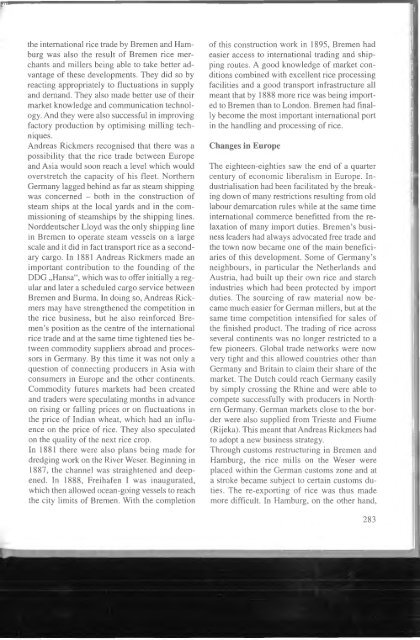Dannhauer - 2013 - Deutscher Reishandel 1850 bis 1914 die zentrale R
Dannhauer - 2013 - Deutscher Reishandel 1850 bis 1914 die zentrale R
Dannhauer - 2013 - Deutscher Reishandel 1850 bis 1914 die zentrale R
Create successful ePaper yourself
Turn your PDF publications into a flip-book with our unique Google optimized e-Paper software.
рпthe<br />
international rice trade by Bremen and Hamburg<br />
was also the result of Bremen rice merchants<br />
and millers being able to take better advantage<br />
of these developments. They did so by<br />
reacting appropriately to fluctuations in supply<br />
and demand. They also made better use of their<br />
market knowledge and communication technology.<br />
And they were also successful in improving<br />
factory production by optimising milling techniques.<br />
Andreas Rickmers recognised that there was a<br />
possibility that the rice trade between Europe<br />
and Asia would soon reach a level which would<br />
overstretch the capacity of his fleet. Northern<br />
Germany lagged behind as far as steam shipping<br />
was concerned - both in the construction of<br />
steam ships at the local yards and in the commissioning<br />
of steamships by the shipping lines.<br />
Norddeutscher Lloyd was the only shipping line<br />
in Bremen to operate steam vessels on a large<br />
scale and it did in fact transport rice as a secondary<br />
cargo. In 1881 Andreas Rickmers made an<br />
important contribution to the founding of the<br />
DDG „Hansa“, which was to offer initially a regular<br />
and later a scheduled cargo service between<br />
Bremen and Burma. In doing so, Andreas Rickmers<br />
may have strengthened the competition in<br />
the rice business, but he also reinforced Bremen’s<br />
position as the centre of the international<br />
rice trade and at the same time tightened ties between<br />
commodity suppliers abroad and processors<br />
in Germany. By this time it was not only a<br />
question of connecting producers in Asia with<br />
consumers in Europe and the other continents.<br />
Commodity futures markets had been created<br />
and traders were speculating months in advance<br />
on rising or falling prices or on fluctuations in<br />
the price of Indian wheat, which had an influence<br />
on the price of rice. They also speculated<br />
on the quality of the next rice crop.<br />
In 1881 there were also plans being made for<br />
dredging work on the River Weser. Beginning in<br />
1887, the channel was straightened and deepened.<br />
In 1888, Freihafen I was inaugurated,<br />
which then allowed ocean-going vessels to reach<br />
the city limits of Bremen. With the completion<br />
of this construction work in 1895, Bremen had<br />
easier access to international trading and shipping<br />
routes. A good knowledge of market conditions<br />
combined with excellent rice processing<br />
facilities and a good transport infrastructure all<br />
meant that by 1888 more rice was being imported<br />
to Bremen than to London. Bremen had finally<br />
become the most important international port<br />
in the handling and processing of rice.<br />
Changes in Europe<br />
The eighteen-eighties saw the end of a quarter<br />
century of economic liberalism in Europe. Industrialisation<br />
had been facilitated by the breaking<br />
down of many restrictions resulting from old<br />
labour demarcation rules while at the same time<br />
international commerce benefited from the relaxation<br />
of many import duties. Bremen’s business<br />
leaders had always advocated free trade and<br />
the town now became one of the main beneficiaries<br />
of this development. Some of Germany’s<br />
neighbours, in particular the Netherlands and<br />
Austria, had built up their own rice and starch<br />
industries which had been protected by import<br />
duties. The sourcing of raw material now became<br />
much easier for German millers, but at the<br />
same time competition intensified for sales of<br />
the finished product. The trading of rice across<br />
several continents was no longer restricted to a<br />
few pioneers. Global trade networks were now<br />
very tight and this allowed countries other than<br />
Germany and Britain to claim their share of the<br />
market. The Dutch could reach Germany easily<br />
by simply crossing the Rhine and were able to<br />
compete successfully with producers in Northern<br />
Germany. German markets close to the border<br />
were also supplied from Trieste and Fiume<br />
(Rijeka). This meant that Andreas Rickmers had<br />
to adopt a new business strategy.<br />
Through customs restructuring in Bremen and<br />
Hamburg, the rice mills on the Weser were<br />
placed within the German customs zone and at<br />
a stroke became subject to certain customs duties.<br />
The re-exporting of rice was thus made<br />
more difficult. In Hamburg, on the other hand.<br />
283

















